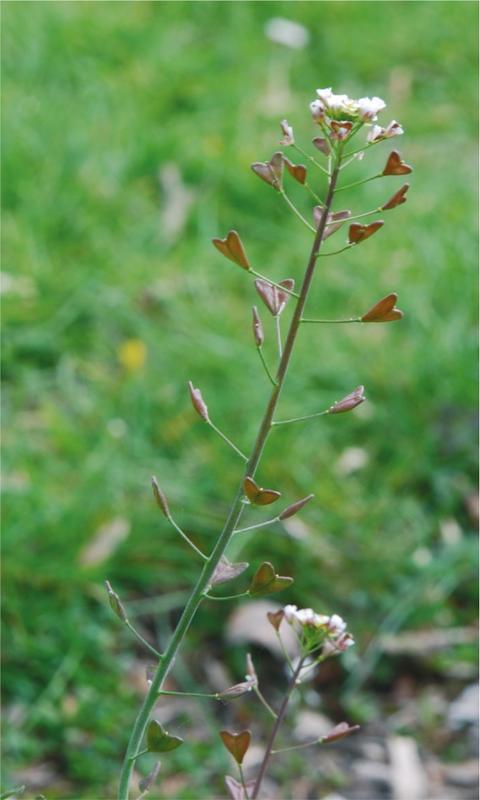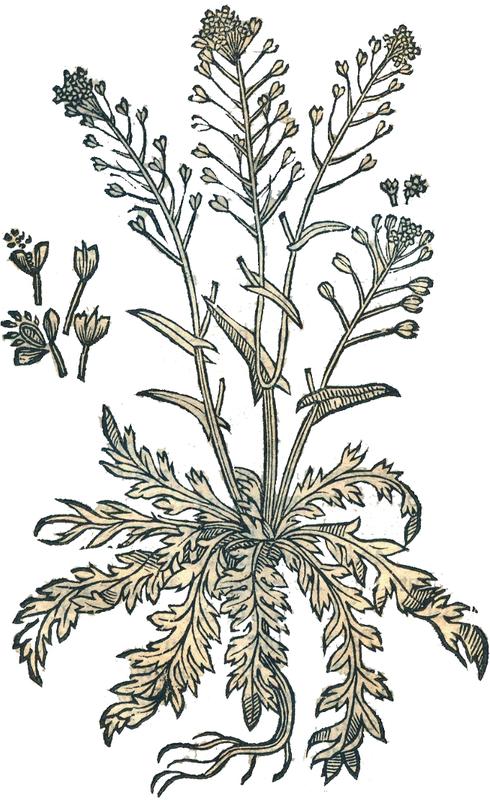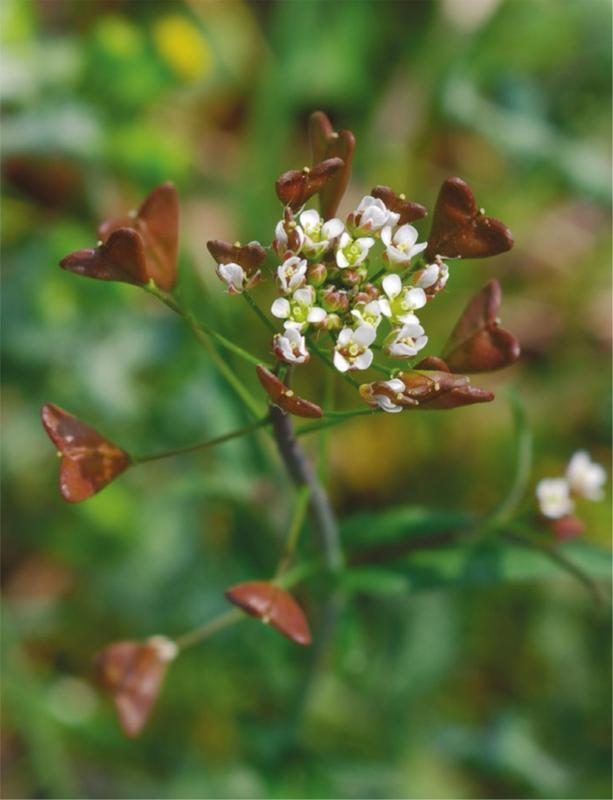Shepherd’s purse stops bleeding of all sorts from nosebleeds to blood in the urine. It was used in First World War battles to staunch bleeding from wounds when ergot, an effective but more dangerous remedy, was not available.
Shepherd’s purse also has an amazing ability to correct prolapses, especially of the uterus but also of the bladder, moving the organs back into their correct position.
Brassicaceae (Cruciferae) Cabbage family
Description: Most easily recognised by its heart-shaped seed pods, this is a small annual with a rosette of slightly hairy, lobed leaves and tiny white flowers.
Habitat: Cultivated and disturbed ground.
Distribution: Widespread throughout the British Isles. Native to Europe and Asia but naturalised in North America and other temperate regions.
Related species: There are several other plants in the genus. Pink shepherd’s purse (C. rubella) has pink flowers and is occasionally found in the British Isles.
Parts used: Above-ground parts.
This common little herb, which most people know as a weed if at all, has an ancient history of herbal use, suggested in its beautiful Latin name. The plant’s seed cases are said to resemble the heart-shaped satchels once worn on men’s belts, whether shepherds or not.
Use shepherd’s purse for…
The aerial parts of shepherd’s purse are all used herbally. Externally, it has been found excellent and safe in treating rheumatic aches and pains, and for ecchymosis, ie bleeding beneath the skin. Taken internally for kidney and bladder irritation, it is particularly good for mucus in the urine.
Less well known is its ability to treat prolapses. Julie had first-hand experience when she suffered a uterine prolapse. Within an hour of taking shepherd’s purse tincture she could feel the uterus moving back into place, and three hours later the discomfort was mostly gone. She was back to normal in three days with the tincture, helped by yoga and reflexology.

Another case history involved a patient who had great discomfort and a bulging on the side of her vulva. She went to the nurse at the doctor’s surgery, who examined her and said she had a uterine prolapse. The patient started taking shepherd’s purse, and felt a fairly rapid improvement. Six days later, her GP examined her again and said the nurse must have made a mistake because the patient didn’t have a prolapse at all.
Shepherd’s purse also works for bladder prolapse. A woman had been diagnosed with this condition, which was causing her pain and discomfort. She didn’t want surgery, so came to see Julie.
The formula Julie gave was shepherd’s purse and a bladder tea of uva ursi, couch grass, buchu, corn-silk and horsetail. To support this, the patient began Pilates and did Kegel, ie pelvic floor, exercises. After a month she felt much better, and her doctor was amazed. Her urine had cleared. Two months later there were no signs of any problem and she felt fantastic.

Illustration of shepherd’s purse from Theatrum Botanicum by John Parkinson, published in 1640

Shepherd’s purse has small white flowers, which are quickly followed by the plant’s signature heart-shaped pods.
Shepherd’s purse has been used during childbirth to stimulate uterine contractions and reduce postpartum bleeding.
For high blood pressure, shepherd’s purse combines well with hawthorn and lime blossom. Mix the tinctures together, using 50ml hawthorn, 30ml lime blossom and 20ml shepherd’s purse. Take 20 drops in a little water or juice twice a day.
During the First World War in Germany shepherd’s purse was used as a less toxic substitute for ergot to stop bleeding.
One of Julie’s patients complained of blood in his urine. The man’s GP had found that the blood was coming from weak blood vessels in his prostate. Shepherd’s purse soon stopped the bleeding, and he then took bilberry to strengthen the blood vessels. He occasionally needed to take shepherd’s purse over the next year, but had no later bleeding problem.
Shepherd’s purse puts out flowers and seeds virtually all year round. It is best picked in the summer for making a tincture, but can be used fresh at any time. The leaves are tastiest before the flowers appear and can be eaten in salads; they are rich in vitamins A, B and C. The seedpods can be used chopped up in soups and stews for their peppery taste. In Japan, shepherd’s purse is grown as a vegetable and to flavour rice.
Because the flowering plant has a rather unpleasant taste, we prefer the tincture form (where a small dose is sufficient) rather than as an infusion or decoction, although these will work perfectly well too.

When all thoughts
Are exhausted
I slip into the woods
And gather
A pile of shepherd’s purse.
Like the little stream
Making its way
Through the mossy crevices
I, too, quietly
Turn clear and transparent.
Zen Master Ryokan (1758–1831)
Shepherd’s purse tincture
Pick shepherd’s purse while it is flowering, preferably in the summer. Fill a jar with the herb, then pour on vodka until it is covered. Put the jar away in a cool dark cupboard for a month, shaking the jar daily or as frequently as you can remember to do it. Strain off the liquid, pour it into a bottle and label.
Dose: For bleeding, take half a teaspoonful three times a day until the bleeding stops and then discontinue. For prolapse, 5 drops three times a day in a little water is usually sufficient. Continue taking it for a few days after everything has moved back into place.
Formula for high blood pressure
Combine tinctures: 2 parts shepherd’s purse, 3 parts lime blossom and 5 parts hawthorn berry.
Dose: 20 drops twice daily in water.